This article may be too technical for most readers to understand.(December 2015) |
| Part of a series on |
| Jainism |
|---|
 |
Tapa Gaccha is the largest Gaccha (monastic order) of Svetambara Jainism.
This article may be too technical for most readers to understand.(December 2015) |
| Part of a series on |
| Jainism |
|---|
 |
Tapa Gaccha is the largest Gaccha (monastic order) of Svetambara Jainism.
Tapa Gaccha was founded by Acharya Jagatchandra Suri in Vikram Samvat 1285 (1228 AD). He was given the title of "Tapa" (i.e., the meditative one) by the ruler of Mewar. This title was applied to the group. [1]
Under Vijayanandsuri's leadership and other monks, Shwetambara Murtipujak Conference was established in 1893 which reformed mendicant as well as lay religious practices. As a result of this reform, most Shwetambara Jain monks today belong to Tapa Gaccha. [1]
Today, the majority of its followers live in states such as Gujarat, Maharashtra, Tamil Nadu, West Bengal, Punjab and Rajasthan. [2]
Later Tapa Gaccha is followed by 21 different samuday or orders. The sects follow different rituals but they do not have differences about scriptures. [1]
Some of these differences include Tithi (calendar date), veneration of gurus, pilgrimage of Palitana temples during monsoon and Santikaram (a religious text) chanting on Chaturdasi (14th day in each half of month in Jain calendar). [1] [3] [4]
Till the time of Nemisuri, there was a unity in Tapa Gachcha.In 1935, on Samvatsari, the last day of Paryushan, Ramchandrasuri order observed it on a different day. [4] This became a sectarian issue and Tapa Gaccha separated into Be Tithi Paksh or 'two date fraction'and'Ek Tithi Paksh or 'one date fraction'. Anandji Kalyanji Trust, which manages 1200 Jain temples, unsuccessfully attempted several times to resolve the issue. [4]
Other distinguishing factors include veneration of gurus using Vasakshep (a sandalwood powder used for worship) between these two fractions. Be tithi fraction believe that Guru or Acharya should be venerated by Navangi Guru Poojan, spreading powder on nine points of body while Ek tithi fraction believe that it should be spread on one point of body, Akangi Guru Poojan. Both fractions differ on pilgrimage of Palitana temples on mount Shatrunjay by lay persons during monsoon season. [4]
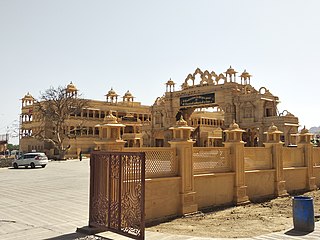
Jirawala Tirth is a Jain temple in Jirawala village of Sirohi District in Rajasthan, India. It lies 58 km from Abu Road. The temple is considered an important Jain pilgrimage center.

Rishabhanatha, also Rishabhadeva, Rishabha or Ikshvaku, is the first tirthankara of Jainism. He was the first of twenty-four teachers in the present half-cycle of time in Jain cosmology, and called a "ford maker" because his teachings helped one cross the sea of interminable rebirths and deaths. The legends depict him as having lived millions of years ago. He was the spiritual successor of Sampratti Bhagwan, the last Tirthankar of previous time cycle. He is also known as Ādinātha, as well as Adishvara, Yugadideva, Prathamarajeshwara and Nabheya. He is also known as Ikshvaku, establisher of Ikshvaku dynasty. Along with Mahavira, Parshvanath, Neminath, and Shantinath, Rishabhanatha is one of the five Tirthankaras that attract the most devotional worship among the Jains.

Acharya Rajendrasuri was a Svetambara Jain monk and reformer of monk traditions of the 19th century. He wrote many books on Jainism including अभिधान राजेंद्र कोष
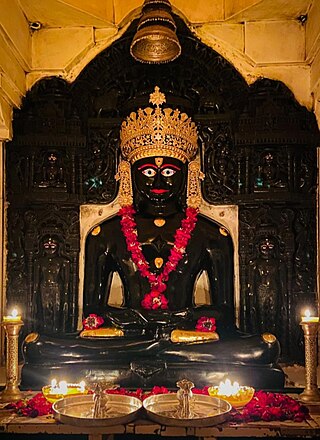
Neminātha, also known as Nemi and Ariṣṭanemi, is the twenty-second Tīrthaṅkara of Jainism in the present age. Neminatha lived 81,000 years before the 23rd Tirthankara Parshvanatha. According to traditional accounts, he was born to King Samudravijaya and Queen Shivadevi of the Yadu dynasty in the north Indian city of Sauripura. His birth date was the fifth day of Shravana Shukla of the Jain calendar. Krishna, who was the 9th and last Jain Vasudev, was his first cousin.
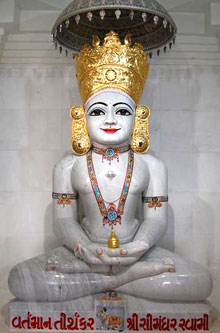
Mūrtipūjaka, also known as Derāvāsī ("temple-dweller") or Mandir Mārgī, is the largest sect of Śvetāmbara Jainism. Mūrtipūjaka Jains differ from both Śvetāmbara Sthānakavāsī and Śvetāmbara Terāpanthī Jains in that they worship images of the Tīrthaṅkaras. Mūrtipūjaka may also generally describe members of both the Śvetāmbara and Digambara traditions who use idols (mūrti) in their worship (pūjā).
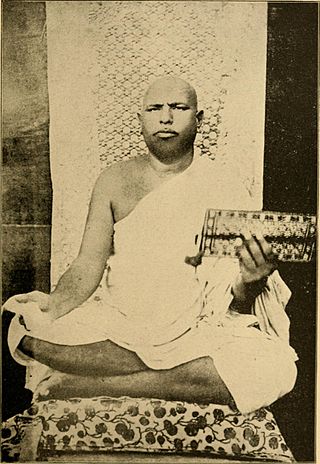
Acharya Vijayanand Suri, also known as Atmaramji of Gujranwala, was the first Swetambar Murtipujaka Jain monk in modern times to receive the title of Acharya. Born and raised in Punjab, he was initiated as a Sthanakvasi monk and later joined the Murtipujaka tradition. He travelled extensively in Gujarat, Rajputana and Punjab; he organised and reformed Jain community, ascetic orders and literature. He wrote several books in Hindi and was invited to the first World Parliament of Religions in 1893 which was attended by Virchand Gandhi later.
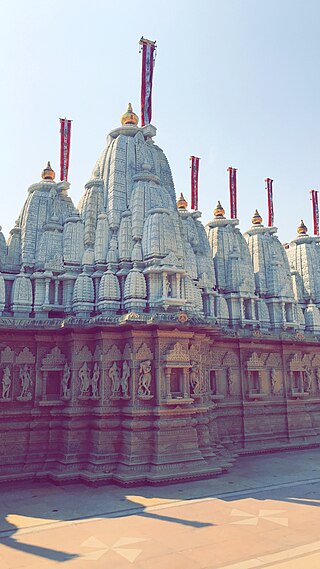
The Shankheshwar Jain Temple is located in the center of Shankheshwar town of Patan district, Gujarat, India. The temple is dedicated to Parshwanath and is an important place of pilgrimage for the followers of Jainism.

Acharya Vijay Vallabhsuri was a Jain monk. He was a disciple of Vijayanandsuri. He worked in Punjab so he was given honorific Punjab Kesari.
Hiravijaya (1526–1595), also known as Muni Hiravijayji and Hiravijay Suri, was a high priest of the Tapa Gaccha monastic order, following the Jain Svetambara tradition. He is known for propounding the Jain philosophy to Mughal Emperor Akbar and turning him towards vegetarianism.
Ghantakarna Mahavira is one of the fifty-two viras of Svetambara Jainism. He is chiefly associated with Tapa Gaccha, a monastic lineage. He was a deity of the Jain tantrik tradition. There is a shrine dedicated to him at the Mahudi Jain Temple established by Buddhisagar Suri, a Jain monk, in nineteenth century. It is one of the popular Jain pilgrimage centres of India.

Ranakpur Jain temple or Chaturmukha Dharana Vihara is a Śvētāmbara Jain temple at Ranakpur dedicated to Tirthankara Rishabhanatha. The temple is located in a village of Ranakpur near Sadri town in the Pali district of Rajasthan.

Kharatara Gaccha is one of Shvetambara Murtipujaka Gacchas. It is also called the Vidhisangha or Vidhimarga, as they regard their practices as scripturally correct.
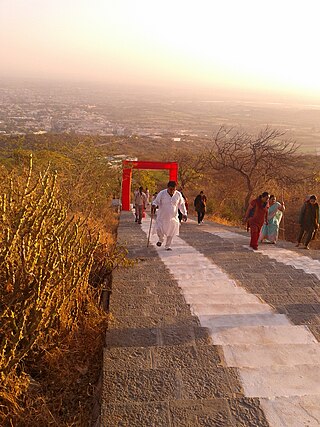
Shatrunjaya or Shetrunjaya originally Pundarikgiri), are hills located by the city of Palitana, in Bhavnagar district, Gujarat, India. They are situated on the banks of the Shetrunji River at an elevation 164 feet (50 m) above sea level. These hills have similarities to other hills where Jain temples have been built in Bihar, Gwalior, Mount Abu and Girnar.

The Palitana temples, often known only as Palitana, are a large complex of Jain temples located on Shatrunjaya hills near Palitana in Bhavnagar district, Gujarat, India. Also known as "Padliptapur of Kathiawad" in historic texts, the dense collection of almost 900 small shrines and large temples have led many to call Palitana the "city of temples". It is one of the most sacred sites of the Svetambara tradition within Jainism. The earliest temples in the complex date as far back as the 11th century CE.

Jainism is an Indian religion which is traditionally believed to be propagated by twenty-four spiritual teachers known as tirthankara. Broadly, Jainism is divided into two major schools of thought, Digambara and Śvetāmbara. These are further divided into different sub-sects and traditions. While there are differences in practices, the core philosophy and main principles of each sect is the same.
Gaccha, alternatively spelled as Gachchha, is a monastic order, along with lay followers, of the image worshipping Murtipujaka Svetambara sect of Jainism. The term is also used in the Digambara sect.
Jain festivals occur on designated days of the year. Jain festivals are either related to life events of Tirthankara or they are performed with intention of purification of soul.
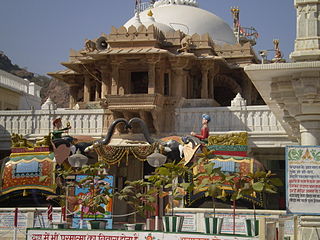
Nakodaji Tirth is a major Jain tirth in the Indian state of Rajasthan, located between the villages of Vikrampura and Nakoda in Barmer District. The temple houses the icon of Nakoda Bhairava, a popular Shvetambara guardian deity.

Kesariyaji Tirth or Rishabhdeo Jain temple is a Jain temple located in Rishabhdeo town of Udaipur District of Indian state of Rajasthan. The temple is considered an important pilgrimage center by both Digambara and Śvētāmbara sect of Jainism.

Daulatsagarsuri was a Jain ascetic, philosopher, and a revered saint belonging to the Śvetāmbara sect. He was the head of the monastic order (Gacchadhipati) of the "Sagar Samudaay" of the Tapa Gaccha. While he was alive, he was the preceptor of 900 monks and nuns. He was awarded the rarest of the rare and ancient title of "Shri Sangh Sthavir" based on his austerity, knowledge of the canonical scriptures of Jainism, and spiritual leadership, becoming the only second of the modern Jain ascetics to have achieved this feat.